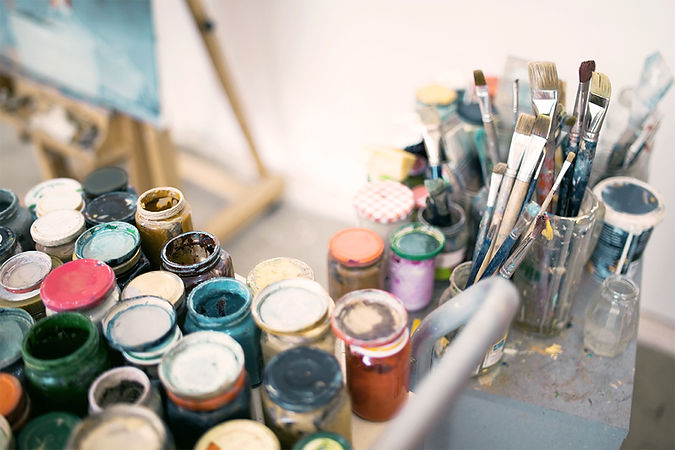
CREATE.
Created, Developed and Maintained by Miranda Koffey
Create. is an online resource from and for the creative world. In an increasingly virtual education landscape, teaching and learning about art and artmaking can be tough- this site is designed to provide inspiration through exploration. Relying on densely packed pages and visuals, visitors can move in and out of the site to discover new artists, methods, mediums, cultures, and knowledge.
Create. was developed during the transition from in-person to virtual learning during the COVID-19 interruption. During The Ohio State University’s spring break, instructors and students received daily emails updating them on university plans to combat COVID-19. These plans included an order for all courses to move to a strict virtual format and an extension of break so students could quickly vacate dorms and instructors could plan. By the second week, we were notified the disruption would last for the five remaining weeks of the semester. As an instructor, I was inundated with ‘how-tos’ for teaching online and various resources for educators from the college through email and from my peers and friends via social media. As a student, I watched as my professors went through the same struggle I was, and received various drafts of additional plans for the semester, followed up with, I overestimated all of this- so we’re going to cut a few things. A few gave up on normalcy, while others tried to maintain our intended schedules and syllabus. Within a week of being instructed to move my art-making course for pre-service educators, I was overwhelmed with ideas on how to make my syllabus virtual-friendly, while still completing course goals. Constant updates were emailed to us from the college, the department, and course advisers reminding us that our students were experiencing unprecedented amounts of change and stress. The blunt truth I came to understand during this planning period- my class would not be anyone’s top priority for some time.
Although creating and releasing a website of resources and tools would remove me as the educator in the room, being a critical multicultural educator makes me responsible to put forward critical and meaningful materials for my students, and anyone else who visits the site. Acuff, (2018) explains, “‘Being’ a critical multicultural pedagogue means consistently questioning the status quo and exercising a critical consciousness. The wider structural constraints, such as racism, classism, sexism, and heterosexism, need to be examined in order for radical change to happen in the current order” (p. 45). Preceding this critical examination for change, scholars of and advocates for critical multicultural education remind us that students bring their prior knowledge into our classrooms to make sense of the world and the work toward improving it- it can be assumed they will do the same to a virtual classroom, even one without an educator present (Ladson-Billings, 1999; May & Sleeter, 2010; Stuhr, Ballengee Morris, & Daniel, 2008).
Cultural misrepresentation through online art educational resources is common, and disallows students from gaining critical insight, othering any art and artmaking outside the dominant western canon. Acuff (2014) explains;
The multicultural art lesson plans on these websites make little to no distinction between a culture’s historical and contemporary context. The art products that result from the lessons are consistently utilitarian or directly relational to things like historical rituals, religion or mythical belief systems, e.g. African masks, Indian masks... Consequently, this easily communicates to students who complete the projects that these often non-secular derived cultures are primitive, as their art deviates far from the norm (Eurocentric standard) (p. 309).
Create. attempts to provide critical resources, projects, and inspiration from a wider canon of artists and artwork that tackles and discusses issues of racism, sexism, classism, heterosexism. Projects are designed to give holistic insight into otherwise Eurocentric topics. If you see issues, or have questions- please Contact Us.
Resources:
Acuff, J. B. (2014). (Mis)information highways: A critique of online resources for multicultural art education. International
Journal of Education through Art, 10(3), 303-316.
Acuff, J. B. (2018). 'Being' a critical multicultural pedagogue in the art education classroom. Critical Studies in Education, 59(1),
35-53.
Kraehe, A. M., Gaztambide-Fernández, R., & Carpenter II, B. S. (2018). The arts as white property: An introduction to race,
racism, and the arts in education. The palgrave handbook of race and the arts in education (pp. 1-31). Cham: Palgrave
Macmillan.
Ladson-Billings, G. (1999). Preparing teachers for diverse student populations: A critical race theory perspective. Review of
Research in Education, 24(1), 211-247.
Lorde, A. (1997). Age, race, class, and sex: Women redefining difference. In A. McClintock, A. Mufti & E. Shohat (Eds.),
Dangerous liaisons: Gender, nation and postcolonial perspectives (pp. 374-383). Minneapolis, MN: University of Minnesota
Press.
May, S., & Sleeter, C. (2010). Critical multiculturalism: Theory and praxis. New York, NY: Routledge.
Stuhr, P., Ballengee Morris, C., & Daniel, V. (2008). Social justice through curriculum: Investigating issues of diversity. In R. Mason, & T. Esca (Eds.),
International dialogues in art education (pp. 81-95). Bristol, England: Intellect Books.